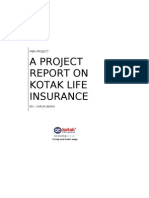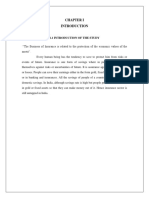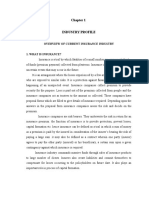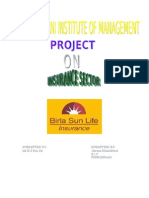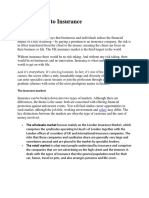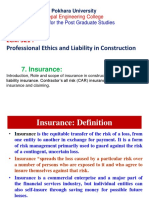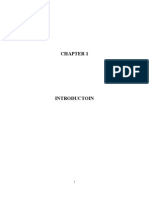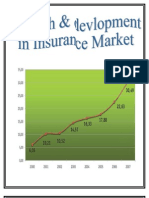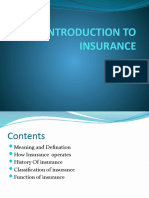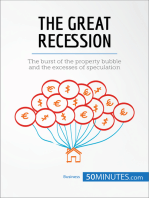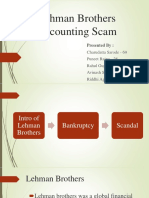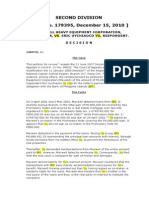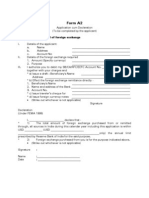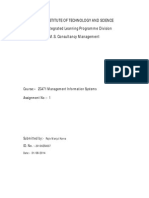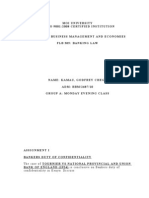A Study On Investors Perception Towards Derivative Market
A Study On Investors Perception Towards Derivative Market
Uploaded by
Rajani KanthCopyright:
Available Formats
A Study On Investors Perception Towards Derivative Market
A Study On Investors Perception Towards Derivative Market
Uploaded by
Rajani KanthOriginal Title
Copyright
Available Formats
Share this document
Did you find this document useful?
Is this content inappropriate?
Copyright:
Available Formats
A Study On Investors Perception Towards Derivative Market
A Study On Investors Perception Towards Derivative Market
Uploaded by
Rajani KanthCopyright:
Available Formats
CHAPTER I
INTRODUCTION
. 1.1 INTRODUCTION OF THE STUDY
The Business of Insurance is related to the protection of the economic values of theassets.
Every human being has the tendency to save to protect him from risks orevents of future.
Insurance is one form of savings where in people try to assurethemselves against risks or
uncertainties of future. It is assurance against risks or eventsor losses. People can save their
earnings either in the form gold, fixed assets like propertyor in banking and insurances. All the
savings of people of a country account for grossdomestic savings. In India, although savings rate
is high but people prefer to invest eitherin gold or fixed assets so that they can make money out
of it. Hence insurance sector isstill untapped in India.
1.2 INDUSTRY PROFILE OVERVIEW OF CURRENT INSURANCE INDUSTRY1.
WHAT IS INSURANCE?
Insurance is a tool by which fatalities of a small number arecompensated out of funds (premium
payment) collected from plenteous. Insurance is asafeguard against uncertain events that may
occur in the future. It is an arrangement where the losses experienced by a few are extended
overseveral who are exposed to similar risks. It is a protection against financial loss arising onthe
happening of an unexpected event. Insurance companies collect premium to providesecurity for
the purpose. Loss is paid out of the premium collected from people and theinsurance companies
act as trustees to the amount so collected. These companies haveproposal forms which are filled
to give details of insurance required. Depending upon theanswers in the proposal form insurance
companies assess the risk and decide on thepremium. Insurance companies are risk bearers. They
underwrite the risk in return for aninsurance premium. the function of insurance is to provide
protection, prevent losses,capital formation etc. hence insurance can be defined as a tool in
which a sum of moneyas a premium is paid by the insured in consideration of the insurers
bearing the risk ofpaying a large sum .it may also be defined as a contract wherein one party
(insurer)agrees to pay the other party (insured) or his beneficiary, a certain sum upon a
givencontingency against which insurance is required. Insurance industry commands massive
funds through sales of insurance productsto large number of clients. Insurers also create
liabilities and commit themselves tocompensate for losses occurring to the policyholders on
future date. It also plays animportant role in process of capital formation.
2. NATURE OF INSURANCE
A.Risk sharing and risk transfer: Insurance is used to share the financial losses that might occur
to an individual or his family on the happening of specified events. The loss arising from such
events are shared by all the insured in the form of premium. Example: suppose in a village, there
are 250 houses, each valued at Rs.200000.Everyyear one house gets burnt, resulting into a total
loss of Rs 200000.If all the 250 owners come together and contribute Rs.800 each, the common
fund would be Rs200000.This is enough to pay to the owner whose house gets burnt. Thus the
risk of one owner is spread over 250 house owners of the village.
b) Risk assessment in advance: Insurance companies are risk bearers. They assess the risk before
insuring to charge the amount of premium.
c) Its not gambling or charity: The uncertainty is changed to certainty by insuringproperty and
life because the insurer promises to pay a definite sum at damage or death.Insurance is antithesis
of gambling. Failure of insurance amounts to gambling becausethe uncertainty of loss is always
looming. Moreover insurance is not possible withoutpremium. So it is different from charity
because charity is given without consideration.
d) Huge number of insured people: It is essential to insure larger number of people orproperty to
make cost of insurance less consequently premium would also be less.
e) Assists in capital formation: Insurance provides capital to society. Accumulative funds are
invested in productive channels.
SEMANTICS
1. Risk: It is defined as an uncertainty of a financial loss. It is the unintentional decline in or
disappearance of value arising from contingency.
2. Policy: It is the document which embodies the insurance contract
3. Whole life policy: It is the policy under which the amount of policy will be paid only on death
of the insured. Premiums may be payable throughout the life or for a limited period.
4. Endowment policy: Endowment policies entitle the insured to receive the amount of the policy
on his reaching a certain age and premiums also stops. If death occurs earlier, amount of the
policy will be paid at that time and payment of premium will also stop at that time.
5. Claim: It is the amount which an insurer has to pay against a policy.
6. Reinsurance: It refers to placing a part of the risk by an insurer with another insurer. The
object is to reduce the possible loss to be borne by the original insurer, who pays premiums at the
ordinary rates to the reinsurer. Reinsure must pay commission to the original insurer.
7. Premium: A periodic payment made on an insurance policy.
8. Insurance penetration: It is defined as insurance premium as a share of gross domestic product.
9. Insurance density: Insurance density is defined as per capita expenditure on insurance
premium i.e. premium per capita.
10. Actuary: The actuary is a specialist who combines an understanding of risks and
mathematical technique to develop financial products to manage these risks, price these products.
He helps in designing insurance plans and then evaluates the financial risk of the company which
it takes while selling an insurance policy.
4. TYPES OF INSURANCE
Insurance is broadly divided in two segments, based on the nature of insurance, those are: 1. Life
Insurance & 2. Non-Life Insurance or General Insurance. It can be again subdivided into the
following categories: a) Fire Insurance. b) Marine Insurance. c) Social Insurance & d)
Miscellaneous Insurance. (Health insurance, Liability Insurance etc.)
HISTORY OF INSURANCE GLOBAL
For now we know the meaning of insurance, different types of insurance. Now letus know the
history and reasons for and behind different types of insurance. Insurance has existed for
thousands of years. The first ever type of insurance wasProperty Insurance. It became popular
about 3000 BC in China. It all started whenChinese merchants, as well as their investors, wanted
to ensure that they would see aprofit from their goods that they shipped overseas. In the event
that a ship was lost at sea,an insuring partner would reimburse the owners of the ship and goods.
To pay for the lossthe merchant would be sold into slavery to the insurer until the debt was
repaid. This wasso because, a merchant could not afford to pay for the lost goods or even to buy
a shipunless someone invested. Property insurance was also seen in Babylon as well. In Babylon,
merchants andinvestors entered into a contract, in which the supplier of money for a trade agreed
tocancel the loan if the trader was robbed of his goods. The trader who borrowed themoney paid
an extra amount for this protection in addition to the usual interest. As for thelender, collecting
these premiums from many traders made it possible for him to absorbthe losses of the few. Later
this contract was extended to include provisions for a familyshome and even the death of the
insured, where life insurance came into existence. Slowlythis concept started to spread across
other places like Greek, Roman. Since ancient times, communities have pooled some of their
resources to helpindividuals who suffer loss. Like, about 3500 years ago, Moses instructed the
nation ofIsrael to contribute a portion of their produce periodically for "the alien resident and
thefatherless boy and the widow." Later the origin of credit insurance, which was included in the
Code ofHammurabi, a collection of Babylonian laws said to predate the Law of Moses.
Creditinsurance means, in ancient times the ship owners obtained loans from investors tofinance
their trading expeditions. In case, if a ship was lost, the owners were notresponsible to pay back
the loans to the investors. The risk to the lenders was covered bythe interest paid by numerous
ship owners, since many ships returned safely.
1. . By the middle of the 14th century, marine insurance was one of the most populartypes of
insurance among nations of Europe. Things changed dramatically in the 17thcentury in Europe.
In 1666, the Great Fire of London bought the need for fireinsurance .The Great Fire of London
burned for four days and nights. It destroyed 436acres, 13,200 houses, 89 churches (including
Saint Pauls Cathedral), the Custom House,the Royal Exchange and dozens of other public
buildings. Only six people were victimsin the flames, but hundreds died from shock and
exposure. By 1688, Edward Lloyd was running a coffeehouse in London. Where,
Londonmerchants and bankers met informally to do business. There financiers who
offeredinsurance contracts to seafarers wrote their names under the specific amount of risk
thatthey would accept in exchange for a certain payment, called premium. These insurerscame to
be known as underwriters. Finally, in 1769, Lloyds became a formal group ofunderwriters that in
time grew as an insurance company. The concept of insurance developed at a fast pace with the
growth of Britishcommerce in the 17th and 18th century. The first stock companies to engage in
insurancewere chartered in England in the year 1720. In 1735, the first insurance company in the
American colonies was founded atCharleston. Later in the year 1787, fire insurance corporations
were formed in New York.Then later in the year 1759, the life insurance corporation was started
in Philadelphia,America. The New York fire which occurred in the year 1835 was the main
reason to drawattention to create reserves to meet unexpected losses. In the year 1837,
Massachusettswas the first state to require companies by law to maintain such reserves. After
1840, lifeinsurance entered a boom period. The Workmens Compensation Act of 1897 in Britain
required employers toinsure their employees against industrial accidents. Public liability
insurance, fostered bylegislation, made its appearance in the 1880s.It attained major importance
with the adventof the automobile. Until the 1950s, most insurance companies in the United
States were restricted toprovide only one type of insurance, but then legislation was passed to
permit fire and companies to underwrite several classes of insurance. Many firms have
sinceexpanded and also were responsible for many mergers. From this brief accounting of
history we can see how insurance came intoexistence. Fortunately for us we no longer have to
sell ourselves into slavery if our car isstolen nor we have to be scared of losses due to absence of
reserves. However we can beconfident that we will be compensated for our loss. Without people
wanting to securetheir investments and great tragedies throughout history we may not have
insurance as weknow it today resulting in peace of mind.
6. HISTORY OF INSURANCE INDUSTRY IN INDIA
The insurance industry in India over the past century has gone through bigchanges. In India this
industry reveals the 360 degree turn. 360 degree turn means that itstarted in India from being an
open competitive market to nationalization and back to aliberalized market again. Insurance
industry in India started as a fully private system with no restriction onforeign participation in
the Nineteenth Century. Before independence, a few Britishinsurance companies dominated the
Market. Life insurance was first set up in Indiathrough a British company called the Oriental Life
Insurance Company in 1818, followedby the Bombay Assurance Company in 1823 and the
Madras Equitable Life InsuranceSociety in 1829.All of these companies operated in India but did
not insure the lives ofIndians. They were there insuring the lives of Europeans living in India.
Some of thecompanies that started later did provide insurance for Indians. But, they were treated
as"substandard" and therefore had to pay an extra premium of 20% or more. The firstcompany
that had policies that could be bought by Indians with "fair value" was theBombay Mutual Life
Assurance Society starting in 1871. The first general insurance company, Triton Insurance
Company Ltd., wasestablished in 1850. It was owned and operated by the British. The first
general insurancecompany was the Indian Mercantile Insurance Company Limited set up in
Bombay in1907.By 1938; the insurance market in India had nearly 176 companies (both life
andnon-life).
After the independence, the industry went to the other extreme. It became a state-owned
monopoly. The industry started to witness a problem like fraud. Hence manyregulations were put
in place to reduce and control the problems in the industry. Afterwhich Insurance was
nationalized. In 1956, the then finance minister S. D. Deshmukhannounced nationalization of the
life insurance business and then the general insurancebusiness was nationalized in 1972. Only in
1999 private insurance companies have beenallowed back into the business of insurance with a
maximum of 26% of foreign holding.
7.. INDIAN SCENARIO INDIAN INSURANCE INDUSTRY
LIFE NON LIFE INSURANCE INSURANCE
Public Private Public Private Sector (1) Sector (15) Sector (4) Sector (9)
8. LIFE INSURANCE After the entry of new players and increase in the penetration levels,
could see theinsurance sector cross the Rs 2,00,000-core mark in business by 2010.The current
size ofthe sector is estimated to be at Rs 50,000 crore, which has seen a compound annualgrowth
rate (CAGR) of around 175 percent in the last few years. The insurance sector, both life and non
life, is likely to grow by over 200 percent,and private insurers are expected to achieve a growth
rate of 140 percent as a result ofaggressive marketing technique. It added that state owned
insurance companies are likelyto be 35-40 percent. On account of intense marketing strategies
adopted by the private insuranceplayers, the market share of state-owned insurance companies
like GIC, LIC and othershas come down to 70 percent in last 4-5 years from over 97 percent.
Despite regulation,private players are offering 35 percent rate of return to is policy holders
against 20percent by public-sector insurers. The industry body also noted that Indias life
insurance premium is 1.8 percent asa percentage of GDP whereas it is 5.2 percent in the US, 6.5
percent in the South Korea. The services sector offers immense opportunities for expansion
opportunities forexpansion opportunities and the rural market, also, offers tremendous
growthopportunities for insurance companies.
9. GENERAL INSURANCE General insurance in India has been expecting growth except in
some portfolioslike motor insurance, fire and engineering. These portfolios are still under tariff-
thismeans that premium depends on a fixed predetermined rate structure. In India, GDS as a
proportion of GDP at current prices increased from 26.1% in2002-03 to 28.1% in 2003-04.house
hold sector continued to be the major contributor toGDS at 24.3% in 2003-04.this can be
attributed to soft interest rates prevailing in housingsector. General Insurance has low market
penetration. It is 1.95% and ranks 51st.However in collection of premium it is ranked 23rd. The
ratio of the premium collected tothat of GDP is 0.58. The main reason for the general insurance
industry to perform verypoorly was because of the slow settlement of claims. Moreover the rates
of claim in Indiawere highest in the world. It was 70 percent compared to 40 percent
internationally. Thismeant that out of 100 people who had insured their commodities 70 claimed
for a loss ordamage. The main reason for the lack of demand for general insurance is that
peopleconsider it as an unnecessary expenditure. However it must be noted that the
generalinsurance has been earning consistent profits and has an efficient dividend paying
recordaccompanied by a steady growth in its financial resources. The industry is recognized
asone of the largest financial Institutions in the country. Some of the private players in thissector
are- ICICI Lombard, Reliance, Royal-Sundaram, Chholamandalam etc.
10. PRIVATE PLAYERS IN THE LIFE INSURANCE SECTOR
The different private players in the life insurance sector and their associations with foreign
companies are being given below:
COMPANY INDIAN FOREIGN TOTAL FDI FOREIGN PROMOTER/PARTNER INSURER
CAPITAL (%) CAPITAL (RS MN.) (RS MN.)AMP RELIANCE None 2,170 0 0SANMAR
GROUP(ADAG)Aviva Life Dabur Aviva (UK) 4,590 26 1193.4Bajaj- Bajaj Auto Allianz 3680
26 960Allianz (Germany)Birla Sun Aditya Birla Group SunLife (Canada) 4,000 26
1,040LifeHDFC HDFC StandardLife 2,500 18.9 470Standard (UK)ICICI ICICI Bank Prudential
(UK) 10,850 26 2,820PrudentialING Vysya Vysya Bank ING Ins. 4,400 26 680
(Netherlands)Kotak Kotak Mahindra Bank OldMutual (South 2,600 26 680Mahindra Africa)Old
MutualMax Max India NewYorkLife 5,000 26 1,300Newyork (US)Met Life J&K Bank Met Life
(US) 3,550 26 920Sahara Life Sahara India None 1,000 0 0Ins. ISBI Life SBI Cardiff (France)
3,500 26 910
.TATA AIG TATA Group AIG (US) 3,810 26 990Shriram Shriram Sanlam Life Ins.Bharti AXA
Bharti Group AXA(Australia) Some of the new companies who are waiting to come in to the life
insurance sector are: a. IDBI-FORTIS. b. Syndicate Bank
11. CONTRIBUTION OF THE INSURANCE SECTOR TO INDIAN ECONOMY
Some surveys have predicted that India and China will play a very vital role in theyears to come.
Indian economy can be termed as an emerging economy as it is doublingits GDP in 3 to 5 years
and moreover it is not dependent on any particular sector for itsGDP. If we look at the GDP of
the Indian economy very closely over the years, we caneasily come to know the changing
structure of the economy. We can also come to knowthe changing contribution of the various
sectors like agriculture, manufacturing and theservice sector. In the financial year 1993-94,
agricultural sector contributed to 31%,manufacturing accounted to 26.3% and the service sector
contributed to 42.7% of thetotal GDP of the country. Thus over the years as India became an
emerging economy in2003-04 manufacturing sector contributed for 21.7 %, manufacturing
contributed for 26.8whereas service sector contributed for 51.4% of the total GDP. There has
been 7.5% growth in the total GDP of the country and is estimated togrow at 8.0% in 2006-07.
The Indian economy has shown signs of strong performancedespite a rise in oil prices, high
inflation rate and abnormal rains in many parts of thecountry. The overall growth of the Indian
economy has been equally supported by all thethree sectors of the economy, i.e. the agriculture,
manufacturing and the service sector.Insurance, together with the banking sector, contributes to
about 7.3 % of the total GDPof India, and the gross premium collected contributes to about 2%
of the total GDP of thecountry The insurance sector in India has completed a full circle from
being an opencompetitive market to nationalization and back to a liberalized market again.
Tracing thedevelopments in the Indian insurance sector reveals the 360 degree turn witnessed
over aperiod of almost 200 years.
12. GOVERNMENT POLICIES REGARDING LIFE INSURANCE
Insurance Regulatory and Development Authority (IRDA) 1999Reforms in the insurance sector
were initiated with the passage of the IRDA bill inDecember 1999.it was set up as an
independent body and it has been able to frameglobally compatible legislations.The IRDA was
set up to protect the interests of holders of insurance policies ,toregulate ,promote and insure
orderly growth of the insurance industry and for mattersconnected therewith or incidental
thereto.This act extends to whole of India. With the establishment of this act,
governmentamended Insurance act 1938, Life Insurance Act 1956 and General Insurance Act
1972.IRDA was formed on the recommendations of Malhotra Committee. In 1999 governmentof
India has set up Malhotra Committee to examine the structure of insurance industryand
recommend changes, under R.N Malhotra former governor of RBI.
1.3 COMPANY PROFILE
The Industrial Credit and Investment Corporation of India Limited (ICICI) wasformed in 1955
which is incorporated at the initiative of the World Bank, theGovernment of India and
representatives of Indian industry, with the objective of creatinga development financial
institution for providing medium-term and long-term projectfinancing to Indian businesses.
Mr.A.Ramaswami Mudaliar elected as the first Chairmanof ICICI Limited. ICICI emerges as the
major source of foreign currency loans to Indianindustry. Besides funding from the World Bank
and other multi-lateral agencies, ICICIwas also among the first Indian companies to raise funds
from international markets.1. WHAT IS ICICI GROUP? We are a part of the renowned ICICI
Group, a diversified universal bankinggroup, with a track record of over 50 years in a variety of
financial services.ICICI was formed in 1955, as a result of the focused efforts of the World
Bank, theGovernment of India and the representatives of Indian Industry. Today, ICICI Bank
hasgrown to become Indias second largest bank, with over 24 million customers worldwide.It is
also the first bank from Asia (excluding Japan) to be listed on the NYSE.ICICI Bank is a truly
global bank, with presence at key locations across the globe inBahrain, Bangladesh, Belgium,
Canada, China, Dubai, Hong Kong, Indonesia,Malaysia, Russia, Singapore, South Africa, Sri
Lanka, Thailand, UK, USA and Quatar.ICICI Groups expertise spans a vast range of financial
services, including banking,broking, mutual funds, insurance, home loans, venture funds and
much more. TheGroup is the largest consumer credit provider and the biggest private sector, life
andgeneral insurer in India. Expertise across a vast range of products. All blended to bringyou
seamless financial solutions that ensure you have the advantage in every financialdecision.
Wherever you may be in the world.
2. STRUCTURE OF ICICI GROUP
3. OBJECTIVES OF ICICI GROUPTRUST
We view each client relationship as a partnership for success. We regard your financialneeds
as our own and aim to achieve your investment goals with you. We put our bestresources behind
you to ensure that your investment objectives are more than met.AGILITYWe seek to deliver
superior value to you. We respond quickly and efficiently to marketopportunities, and offer the
most apt financial solutions so that you can reap the bestpossible benefits.
INNOVATION
We believe that the cornerstone of success in todays competitive environment isInnovation. We
seek newer opportunities constantly, to fulfill your emerging needs andwants.4. ICICI BANK
ICICI Bank is Indias second-largest bank with total assets of Rs. 3,767.00 billion(US$ 96 billion)
at December 31, 2007 and profit after tax of Rs. 30.08 billion for thenine months ended
December 31, 2007. ICICI Bank is second amongst all the companieslisted on the Indian stock
exchanges in terms of free float market capitalization*. TheBank has a network of about 955
branches and 3,687 ATMs in India and presence in 18countries. ICICI Bank offers a wide range
of banking products and financial services tocorporate and retail customers through a variety of
delivery channels and through itsspecialised subsidiaries and affiliates in the areas of investment
banking, life and non-lifeinsurance, venture capital and asset management. The Bank currently
has subsidiaries inthe United Kingdom, Russia and Canada, branches in Unites States,
Singapore, Bahrain,Hong Kong, Sri Lanka, Qatar and Dubai International Finance Centre and
representativeoffices in United Arab Emirates, China, South Africa, Bangladesh, Thailand,
Malaysiaand Indonesia. Our UK subsidiary has established branches in Belgium.ICICI Banks
equity shares are listed in India on Bombay Stock Exchange and theNational Stock Exchange of
India Limited and its5. COMPANIES UNDER ICICI BANKA) ICICI PRUDENTIAL AMC
AND TRUST: ICICI Prudential Asset Management Company enjoys the strong parentage
ofprudential plc, one of UKs largest players in the insurance & fund management sectorsand
ICICI Bank, a well-known and trusted name in financial services in India. ICICIPrudential Asset
Management Company, in a span of just over eight years, has forged aposition of pre-eminence
in the Indian Mutual Fund industry as one of the largest assetmanagement companies in the
country with assets under management of Rs. 37,906.24crore (as of March 31, 2007). The
Company manages a comprehensive range of schemesto meet the varying investment needs of
its investors spread across 68 cities in thecountry.Key Indicator: During the year march 1998
Asset Under Management was Rs160 cores with onlytwo funds managed, as on February 29,
2008 now it raised up to Rs 62,008.95 cores with35 funds.
B) ICICI SECURITIES INDIAS LEADING INVESTMENT BANK
A subsidiary of ICICI Bank - the largest and most recognized private bank inIndia ICICI
Securities Ltd is premier Indian Investment Bank, with a dominant positionin its core segments
of its operations - Corporate Finance including Equity CapitalMarkets Advisory Services,
Institutional Equities, Retail and Financial ProductDistribution With a full-service portfolio, a
roster of blue-chip clients and performancesecond to none, we have a formidable reputation
within the industry. The Corporate Finance team regularly ranks highest among the leading
capitalmarkets league tables and recently topped the Prime Database League tables for
fundsmobilized through equity instruments in the first half of CY 07. ICICI Securities Inc., the
step down wholly owned US subsidiary of the companyis a member of the National Association
of Securities Dealers, Inc. (NASD). As a resultof this membership, ICICI Securities Inc. can
engage in permitted activities in the U.S.securities markets. These activities include Dealing in
Securities and Corporate AdvisoryServices in the United States and providing research and
investment advice to USinvestors. ICICI Securities Inc. is also registered with the Financial
Services Authority, UK(FSA) and the Monetary Authority of Singapore (MAS) to carry out
Corporate AdvisoryServices and Dealing in Securities.
C) ICICI VENTURE ICICI Venture is one of the largest and most successful private equity
firms inIndia with funds under management in excess of USD 2 billion.ICICI Venture, over the
years has built an enviable portfolio of companies across sectorsincluding pharmaceuticals,
Information Technology, media, manufacturing, logistics,textiles, real estate etc thereby building
sustainable value.It has several firsts to its credit in the Indian Private Equity industry.
Amongst them areIndias first leveraged buyout (Infomedia), the first real estate investment (
CyberGateway), the first mezzanine financing for a acquisition (Arch Pharmalabs) and the
firstroyalty-based structured deal in Pharma Research & Development (Dr Reddys).ICICI
Venture is a subsidiary of ICICI Bank, the largest private sector financial servicesgroup in
India.D) ICICI LOMBARD GENERAL INSURANCE COMPANY LIMITED ICICI Lombard
General Insurance Company Limited is a 74:26 joint venturebetween ICICI Bank Limited and
the Canada based $ 26 billion Fairfax FinancialHoldings Limited. ICICI Bank is Indias second
largest bank, while Fairfax FinancialHoldings is a diversified financial corporate engaged in
general insurance, reinsurance,insurance claims management and investment management.
Lombard Canada Ltd, a group company of Fairfax Financial Holdings Limited, isone of Canadas
oldest property and casualty insurers. ICICI Lombard General InsuranceCompany received
regulatory approvals to commence general insurance business inAugust 2001.
E) ICICI PRUDENTIAL LIFE INSURANCE COMPANY ICICI Prudential Life Insurance
Company is a joint venture between ICICI Bank,a premier financial powerhouse, and Prudential
plc, a leading international financialservices group headquartered in the United Kingdom. ICICI
Prudential was amongst thefirst private sector insurance companies to begin operations in
December 2000 afterreceiving approval from Insurance Regulatory Development Authority
(IRDA). ICICI Prudential Life Insurance Company is a joint venture between ICICI Bank,a
premier financial powerhouse, and Prudential plc, a leading international financialservices group
headquartered in the United Kingdom. ICICI Prudential was amongst thefirst private sector
insurance companies to begin operations in December 2000 afterreceiving approval from
Insurance Regulatory Development Authority (IRDA). ICICI Prudential Lifes capital stands at
Rs. 37.72 billion (as on February, 2008)with ICICI Bank and Prudential plc holding 74% and
26% stake respectively. For thenine months period April 1 to December 31, 2007, the company
garnered new businessweighted premium of Rs. 4,586 crore and has underwritten around 18 lakh
policiesduring the period. The company has assets held over Rs. 28,000 crore. ICICI Prudential
Life is also the only private life insurer in India to receive aNational Insurer Financial Strength
rating of AAA (Ind) from Fitch ratings. The AAA(Ind) rating is the highest rating, and is a clear
assurance of ICICI Prudentials ability tomeet its obligations to customers at the time of maturity
or claims. For the past seven years, ICICI Prudential Life has retained its leadership positionin
the life insurance industry with a wide range of flexible products that meet the needs ofthe Indian
customer at every step in life.
a) VISION
To be the dominant Life, Health and Pensions player built on trust by world-classpeople and
service.This we hope to achieve by: Understanding the needs of customers and offering them
superior products and service Leveraging technology to service customers quickly, efficiently
and conveniently Developing and implementing superior risk management and investment
strategies to offer sustainable and stable returns to our policyholders Providing an enabling
environment to foster growth and learning for our employees And above all, building
transparency in all our dealingsThe success of the company will be founded in its unflinching
commitment to 5 corevalues ,Integrity, Customer First, Boundaryless, Ownership and Passion.
Each of thevalues describe what the company stands for, the qualities of our people and the way
wework.b) VALUES Every member of the ICICI Prudential team is committed to 5 core
values:Integrity, Customer First, Boundary less, Ownership, and Passion. These values
shineforth in all we do, and have become the keystones of our success.
c) DEPARTMENTS AND BRANCHES OF ICICI PRUDENTIAL LIFEINSURANCE
COMPANY LIMITED
Branches:
ICICI Prudential Life has one of the largest distribution networks amongst privatelife insurers in
India. It has a strong presence across India with over 945 branches inaddition to 550 micro-
offices and an advisor base of 270,000.Distribution Network: There are four different ways of
distributing a Life insurance product namely; 1. Agents (Financial Advisors):- Anybody
possessing the minimum qualification of 10+2 after completing 100 hrs of training from the
training institute approved by IRDA can sell life insurance products of any particular company
which has sponsored him to take the training. This is the most popular distribution channel. 2.
Corporate Agents Any corporate may apply for license to sell insurance after complying with the
requirements of IRDA. 3. Bancassurance If the corporate agent is a bank, then it is known as
bancassurance. Banks can sell the policies to their existing as well as prospective clients. This is
becoming quite popular these days and the bank earns huge fund based income. Bancassurance
has 1% share in total premium collection in 2004-05. 4. Broker They are like corporate agents
with only difference that they can sell the products of more than one insurance
company.Departments: The various departments that can be seen in an insurance organization
and that has been observed by me are as follows:
a) Marketing Department: This department mainly deals with the marketing and promotion part
of the Insurance Company. They spend most of their time in formulating strategies to make their
products known to the common people and to promote the same in a easy and cost effective way.
b) Sales Department: This department mainly deals with the sales part of the Insurance
Company; the department includes designations like Sales Manager and Financial Advisor who
personally contacts with people for performing the task of sales of various products.
c) Accounts/ Financial Department: This department has the task of keeping track of the various
expenses incurred by the various other departments of the organization and also performs the
task of allocating various funds to different departments according to their requirements.
d) Human Resource Department: This department is handled by the Human Resource manager
of the company. The function of this department involves the well being of the employees of the
company, I,e, to see whether there is employee grievance in the organization or not and if it is
there what are the possible causes for that and also try to find out solutions for the same if
possible.
e) Investment Department: This department deals with the task of investing the money of the
policy holders in such way that will ensure both safety of the money and also a steady return on
the same. The task of this department is very difficult as it deals with the money given by the
policy holders, so it requires lot of thinking on the part of the personnel of this department before
deciding where to invest the money.
f) Actuarial Department: This department is under the supervision of an Actuary who decides the
premiums and charges to be taken from the policy holder on the basis of certain informations
(like Age, Annual Income etc.) provided by the prospective customer. The task also involves the
calculation of mortality charges which requires high statistical knowledge from ones point of
view. So, this department involves in the calculation of various amounts to be charged from the
prospective customers.
ICICI PRUDENTIAL LIFE INSURANCE PRODUCTS
Insurance Solutions for Individuals ICICI Prudential Life Insurance offers a range of innovative,
customer-centricproducts that meet the needs of customers at every life stage. Its products can
beenhanced with up to 4 riders, to create a customized solution for each policyholder.Savings &
Wealth Creation Solutions
SavenProtect is a traditional endowment savings plan that offers life protection along with
adequate returns.
CashBak is an anticipated endowment policy ideal for meeting milestone expenses like a childs
marriage, expenses for a childs higher education or purchase of an asset. It is available for terms
of 15 and 20 years.
LifeTime Gold & LifeTime Plus are unit-linked plans that offer customers the flexibility and
control to customize the policy to meet the changing needs at different life stages. Each offer 6
fund options - Preserver, Protector, Balancer, Maximiser, Flexi Growth and Flexi Balanced.
LifeLink Super is a single premium unit linked insurance plan which combines life insurance
cover with the opportunity to stay invested in the stock market.
Premier Life Gold is a limited premium paying plan specially structured for long-term wealth
creation.
InvestShield Life New is a unit linked plan that provides premium guarantee on the invested
premiums and ensures that the customer receives only the benefits of fund appreciation without
any of the risks of depreciation.
InvestShield Cashbak is a unit linked plan that provides premium guarantee on the invested
premiums along with flexible liquidity options.
LifeStage RP is a unique and powerful wealth creation insurance solution, which combines the
benefits of automatic asset allocation and quarterly rebalancing along with increased protection.
Protection Solutions
LifeGuard is a protection plan, which offers life cover at low cost. It is available in 3 options -
level term assurance, level term assurance with return of premium & single premium.
HomeAssure is a mortgage reducing term assurance plan designed specifically to help
customers cover their home loans in a simple and cost-effective manner.Education insurance
plans
Education insurance under the SmartKid brand provides guaranteed educational benefits to a
child along with life insurance cover for the parent who purchases the policy. The policy is
designed to provide money at important milestones in the childs life. SmartKid plans are also
available in unit-linked form - both single premium and regular premium.Retirement Solutions
ForeverLife is a traditional retirement product that offers guaranteed returns for the first 4 years
and then declares bonuses annually.
LifeTime Super Pension is a regular premium unit linked pension plan that helps one
accumulate over the long term and offers 5 annuity options (life annuity, life annuity with return
of purchase price, joint life last survivor annuity with return of purchase price, life annuity
guaranteed for 5, 10 and 15 years & for life thereafter, joint life, last survivor annuity without
return of purchase price) at the time of retirement.
LifeLink Super Pension is a single premium unit linked pension plan. Immediate Annuity is a
single premium annuity product that guarantees income for life at the time of retirement. It offers
the benefit of 5 payout options.
PremierLife Pension is a unique and convenient retirement solution with a limited premium
paying term of three or five years, to suit professionals and businessmen, especially those who
require more flexibility and customization while planning their finances..Health Solutions
Health Assure Plus: Health Assure is a regular premium plan which provides long term cover
against 6 critical illnesses by providing policyholder with financial assistance, irrespective of the
actual medical expenses. Health Assure Plus offers the added advantage of an equivalent life
insurance cover.
Cancer Care: is a regular premium plan that pays cash benefit on the diagnosis as well as at
different stages in the treatment of various cancer conditions.
Cancer Care Plus: is a wellness plan that includes all the benefits of Cancer Care and also
provides an additional benefit of free periodical cancer screenings.
Diabetes Care: Diabetes Care is a unique critical illness product specially developed for
individuals with Type 2 diabetes and pre-diabetes. It makes payments on diagnosis on any of 6
diabetes related critical illnesses, and also offers a coordinated care approach to managing the
condition. Diabetes Care Plus also offers life cover.
Diabetes Care Plus: is a unique insurance policy that provides an additional benefit of life cover
for Type 2 diabetics and pre-diabetics
Hospital Care: is a fixed benefit plan covering various stages of treatment - hospitalisation,
ICU, procedures & recuperating allowance. It covers a range of medical conditions (900
surgeries) and has a long term guaranteed coverage upto 20 years.
Crisis Cover : is a 360-degree product that will provide long-term coverage against 35 critical
illnesses, total and permanent disability, and death.Group Insurance SolutionsICICI Prudential
Life also offers Group Insurance Solutions for companies seeking toenhance benefits to their
employees.Flexible Rider OptionsICICI Prudential Life offers flexible riders, which can be
added to the basic policy at amarginal cost, depending on the specific needs of the customer.
1.4 SCOPE OF THE STUDY
The result of this research would help the company to have a better understanding about the
consumers perception towards life insurance.
The study helps the company by creating awareness about the consumers of different ages and
income levels.
The study also enables the company to focus the consumers preferences and expectations on
the product which they offer.
1.5 OBJECTIVES OF THE STUDIES
a) To know about the various Investment alternatives that is mostly preferred by the people.
b) To find out the important criteria that people think about before investing in a life insurance
policy.
c) To find out whether gender bias involved in investing life insurance or not. d) To find out the
awareness of ICICI Prudential Life Insurance among the people.
1.6 RESEARCH METHODOLOGY
Methodology is a systematic way of solving a problem it includes the research methods for
solving a problem it includes the research methods for solving the problem. Type of research -
Descriptive research Data source -Primary and Secondary data Data collection method -
Interview and survey Data collection tools -Questionnaires Sampling universe -Erode Sample
size -100SAMPLE DESIGN The target population of the study consists of various respondents
of various places. This survey was done by collecting the data from the respondents.SAMPLE
SIZE After due consultation with the company supervisor as well as with the collegeguide, also
keeping in mind the requirements of the company for the research, the samplesize that was found
to be appropriate for the study was 100.SAMPLING TECHNIQUE The sampling technique that
adapted to conduct the survey was ConvenientRandom Sampling and the area of the research
was concentrated in the city of Erodeonly. The survey was conducted by visiting different places
like colleges, corporateoffices, respondents home etc...
DATA SOURCE
The task of data collection begins after a research problem has been defined. Inthis study data
was collected through both primary and secondary data source.
A. PRIMARY DATA A primary data is a data, which is collected for gathering information first
timeand to analyze the problem. In this study the primary data was collected among
theconsumers using questionnaire.
B. SECONDARY DATA Secondary data consist of information that already exits somewhere,
having beencollected for some other purpose. In this study secondary data was collected
fromcompany websites, magazines and brochures.
STATISTICAL TOOLS Simple percentage analysis, ranking method and chi square analysis are
the mainstatistical tool used for the study. SIMPLE PERCENTAGE ANALYSIS Percentage
refers o a special king of ratio in making comparison between two ormore data and to describe
relationships. Percentage can also be used to compare therelation terms between two or more
sources of data. Percentage of respondents = Number of respondents * 100 Total respondents
RANKING METHOD (WEIGHTED AVERAGE METHOD)
This technique was used to rank out the opinion about the consumers preferencetowards different
investment alternatives. The order of merit given by the respondentswas converted into ranks by
using the following formula. Weightage Score = Wi * Xj Where Wi = Weightage value and Xj
= Ranking position value CHI SQUARE TEST Chi Square is a statistical measure used in the
context of sampling analysis forcomparing the variance to a theoretical variance. In order to
judge the significance ofassociation between two attributes, we make use of chi square test by
finding the valuesof chi square using the chi square distribution.
1.7 LIMITATIONS OF THE RESEARCH
The following limitations can be pointed out from the research that I conducted inrelation to the
problems that were given to me by ICICI Prudential Life InsuranceCompany Limited:
a) The sample size chosen for the questionnaire was only 100 and that may not represent the true
picture of the consumer perception about the Life Insurance sector.
b) The research got confined to the city of Erode. The respondent belonged only to Erode and not
others who were out of Erode.
c) Nearly 98% of the respondent belonged to the age group of 20-50 years and only 2% were
above 50 years. So, the responses and the opinions of the experienced and aged were not
available. So, the findings may not be correct when we think about the opinion of the elderly
people about the life insurance.
d) The selection of people for the questionnaire was done on the basis of convenient random
sampling, so, there were certain cases in which the people selected did not have any life
insurance policy, so they could not give any positive feedback regarding the important criteria to
be considered before taking an life insurance policy. So, this further reduced the actual number
of respondents to 76 from 100.
e) The product offered by different companies had different options and names in them, so at the
time of comparison it became very difficult. The parameters for comparison were also different
in the selected companies.
f) One of the important criteria that was selected by the respondents which they consider before
taking an insurance policy was Company Image, but there was no parameter available to
compare criteria like this between the companies.
CHAPTER-II
3.1 FINDINGS
The findings that can be drawn from the survey conducted by us can be summarized inthe
following way:
a) Bank Deposits are the most preferred investment alternative which is available to people
followed by alternatives such as Insurance, Real Estate, Gold and Silver, Mutual etc.
b) It was found that 61 respondents were willing to take a life insurance under LIC and 33
respondents under ICICI Prudential Life Insurance.
c) Among the 76 insurance holders 63 have policy of LIC whereas only 11 respondents have
policy of ICICI Prudential Life Insurance.
d) Only 47% of the total respondents are aware of the joint venture between ICICI bank with
Prudential of UK to form a company called ICICI Prudential Life Insurance in the year 2000. 22
respondents are interested to invest in ICICI because of the companys growth potential and
brand image that ICICI has.
e) The scheme mostly preferred by insurance holders was life protection schemes like death
benefits followed by money growth plans like wealth creation and high return plans.
f) It was found that nearly 50% of the respondents usually save less than 15% and the kind of
investment mostly preferred by the respondents were both long and short term.
g) According to the survey safety is the most important criterion which is excepted among all
the respondents towards their investment alternatives followed by Return, Brand Name, Tax
Benefits, Liquidity and Capital Growth.
h) According to the study company image is to be the highly important criteria which we
consider before taking up a life insurance this is mainly because people expect safety and
security for their money which they invest, followed by the factor Premium which we pay to the
insurer and then Bonus and Interest paid by the company, services etc.
i) People who belong to different age groups have different perception regarding the most
important criteria before taking the decision on a life insurance policy.
j) People who belong to different income groups also have different perception regarding the
important criteria concerned with the life insurance.
3.2 SUGGESTIONS
1. Consumer should be aware of companys profile and returns associated with insurance.
2. The Financial advisor should be right enough to serve the consumers. The consumer should
also be aware of the advisor or others who is looking after their investments.
3. Company should publish their performance by comparing it with their competitors
.4. Company should adopt strategies to explore that private insurance companies are safer and
securer than public insurance company like LIC.
5. Middle income people suggest that premium can be collected on monthly basis instead of
twice a year.
6. Companys reputation is more important because bad impression on image or brand name is
considered while decision making among consumers.
3.3 CONCLUSION
Insurance is a tool by which fatalities of a small number are compensated out offunds collected
from plenteous. Insurance is a safeguard against uncertain events thatmay occur in the future.
Over the last 5 to 6 years, the ICICI Prudential life insurancecompany have tripled investors
money than the other competent, this progress leads toincrease the company image and makes a
way to lead the total insurance market. Thus the study also comprise company image is the
highly important criteria thatconsumers consider before taking up a life insurance. This is mainly
because peopleexpect safety and secure for their money which they invest, followed by the
factorPremium which we pay to the insurer and then Bonus and Interest paid by the
company,services etc.
.REFERENCESTEXT BOOKS
1. PHILIP KOTLER (2001) Marketing Management, Prentice Hall Pvt.Ltd., New Delhi,
Millennium edition.
2. KOTHARI C.R. (1999) Research Methodology, Wishwa Prakashan, New Delhi, 2nd
edition.
3. LEON G. SCHFFMAN and LESLIE LAZAR KANUK (2007) Consumer Behavior, Prentice
Hall Pvt.Ltd., New Delhi, 9th edition.
WEB SITES 1. www.iciciprulife.com
2. www.irda.org
APPENDIX
A Study of Consumers Perception about Life Insurance with special Reference to ICICI
Prudential QuestionnaireDear respondent,This questionnaire is aimed at understanding your
perception about life insurance .Yourresponse will be dealt with strict confidentiality and it will
be used only for academicpurpose. Thank you for spending your valuable time to fill this
questionnaire.
1. Name: Gender: Male Female Contact No:
2. Age Group: Below 30 31-40 41-50 51-60 Above 60
3. Educational Qualification: Under Graduate Post Graduate Diploma Others
(Specify).
4. Occupation: Student Employed Self-Employed Others (Specify).
5. Annual Income Level: Below 1 Lakh 1.01-3 Lakh 3.01-5 Lakh Above 5 Lakh
6. What percentage of your Salary do you usually save? Less Than 15% 15-20% 20-25% Greater
Than 25%
7. What kind of investment do you prefer? Short Term Long Term Both
8. Rank these various investment alternatives according to your preferences. SNO Investment
Alternatives Rank 1. Bonds & Debentures 2. Equity/Shares 3. Mutual Fund 4. Public Provident
Fund(PPF) 5. Post Office 6. Insurance 7. Bank Deposits 8. Real Estate 9. Gold & Silver 10.
Other (specify).
9. State your expectation on investment alternatives by ticking according to its
importance.Expectations on Highly Least Notinvestment important Important Neutral important
importantSafetyCapital GrowthLiquidityReturnTax BenefitCompany Profile &Brand Name
10. Do you have life Insurance Policy? ( If NO then please go to question no.
14) Yes No 11. If Yes Which Insurance Company Policy do you have? LIC Bajaj Allianz
Reliance life ICICI Prudential HDFC Standard Others (Specify)..
12. What scheme of Insurance Policy have you taken? Life protection plan Education plan
Retirement plan Health plan Money growth plan Others (Specify).
13. What parameters do you look into before you take up a life insurance Policy? And tick the
following parameter according to your importance.Parametersconsidered beforeinsurance policy
Highly Neutral Least Not Important Important Important ImportantPremiumChargesPolicy
TermRider BenefitsBonus & InterestServices (Pre &Post Sales)AccessibilityCompany Image
14. Are you aware about the joint venture between ICICI bank with Prudential Plc of UK to form
a first private sector insurance company called ICICI Prudential Life Insurance in December
2000? Yes No
15. Would you like to invest in ICICI Prudential Life Insurance? Yes No
16. If, YES what will make you to invest in ICICI Prudential Life insurance? Brand image
Diversity Growth Potential Transparency Utmost Good Faith Others (Specify).
17. Among the following Life Insurance Companies in which company you will be Willing to
take a life insurance? Bajaj Allianz Birla Sunlife HDFC Standard Life SBI Life ICICI Prudential
TATA- AIG Reliance Met Life Max New York Max New York Sahara ING Vysya ING Vysya
Aviva Dabur OM- Kotak Mahindra LIC AXA-Bharti 18.
You might also like
- A Project Report On Kotak Life InsuranceDocument103 pagesA Project Report On Kotak Life Insurancevarun_bawa25191543% (7)
- Icic BankDocument66 pagesIcic Bankjassi7nishadNo ratings yet
- Insurance BehaviourDocument21 pagesInsurance Behaviourmohini vaityNo ratings yet
- New Consumer Perception Towards Life Insurance in Banking SectorDocument83 pagesNew Consumer Perception Towards Life Insurance in Banking SectorcityNo ratings yet
- Cosumers Perception Towards Insurance - Project ReportDocument112 pagesCosumers Perception Towards Insurance - Project Reportkamdica93% (54)
- Reliance Life InsuranceDocument101 pagesReliance Life InsuranceVicky Mishra100% (2)
- Open Course (Module 4)Document14 pagesOpen Course (Module 4)Sahil AnsariNo ratings yet
- Reliance Life Insurance Market Research1Document105 pagesReliance Life Insurance Market Research12014rajpointNo ratings yet
- Umbrella InsuranceDocument36 pagesUmbrella Insurancesguldekar123No ratings yet
- History of InsuranceDocument36 pagesHistory of InsuranceMurali DharanNo ratings yet
- 08 - Chapter 1 KeshavDocument71 pages08 - Chapter 1 KeshavSAGARNo ratings yet
- Nilesh Pandey (BBI)Document60 pagesNilesh Pandey (BBI)Nilesh PandeyNo ratings yet
- Marketing in InsuranceDocument56 pagesMarketing in Insurancepallavi guravNo ratings yet
- Insurance: by - Vansh Karel Class: 11 Com B ROLL:17Document27 pagesInsurance: by - Vansh Karel Class: 11 Com B ROLL:17VANSH KARELNo ratings yet
- Comparative Study of Reliance & Birla SunlifeDocument64 pagesComparative Study of Reliance & Birla SunlifeRohitParjapat100% (1)
- Insurance ScribdDocument8 pagesInsurance ScribdAnonymous ZJAXUnNo ratings yet
- A Summer Training Project ReportDocument81 pagesA Summer Training Project Reportsumi_kr100% (1)
- What Is Insurance LawDocument55 pagesWhat Is Insurance LawPulkit Mago 1703887No ratings yet
- ArtDocument54 pagesArtpoojatolani3667No ratings yet
- Life Insurance RawDocument33 pagesLife Insurance RawDevesh MestryNo ratings yet
- Unit 1 Study Material LOPDocument21 pagesUnit 1 Study Material LOPmeenasarathaNo ratings yet
- Part - ADocument61 pagesPart - AFrancisco TylerNo ratings yet
- Insurance IndustryDocument8 pagesInsurance IndustryYash ThakkarNo ratings yet
- Blackbook Project On Insurance - 163417159-1Document90 pagesBlackbook Project On Insurance - 163417159-1LIBIN JOSENo ratings yet
- What Is Insurance LawDocument55 pagesWhat Is Insurance LawAbhishek SharmaNo ratings yet
- Birla Sun Life - Garima - Group 3Document30 pagesBirla Sun Life - Garima - Group 3Vikas ChandelNo ratings yet
- Birla Sun Life - Garima - Group 3Document30 pagesBirla Sun Life - Garima - Group 3mukesh chhotalaNo ratings yet
- Blackbook Project On InsuranceDocument77 pagesBlackbook Project On InsuranceAbhayMenon33% (3)
- Introduction To Insurance: The Wholesale Market Focuses Mainly On The London Insurance Market, WhichDocument5 pagesIntroduction To Insurance: The Wholesale Market Focuses Mainly On The London Insurance Market, Whichprasad pawleNo ratings yet
- By - Vansh Karel Class: 11 Com B ROLL:17Document17 pagesBy - Vansh Karel Class: 11 Com B ROLL:17VANSH KARELNo ratings yet
- Nec 7 InsuranceDocument44 pagesNec 7 Insurancenishant khadkaNo ratings yet
- Insurance ProjectDocument99 pagesInsurance Projectjitendra jaushik83% (95)
- 1st UnitDocument32 pages1st UnitDATTUNo ratings yet
- Marine Insurance Executive Summary2Document46 pagesMarine Insurance Executive Summary2baby0310No ratings yet
- Growth & Devlopment in Insurance SectorDocument36 pagesGrowth & Devlopment in Insurance SectorVijay90% (29)
- Insurance Is A Means of Protection From Financial Loss. It Is A Form of RiskDocument11 pagesInsurance Is A Means of Protection From Financial Loss. It Is A Form of RiskMubeenNo ratings yet
- InsuranceDocument83 pagesInsuranceVaheed ManiharNo ratings yet
- Accounting For Fire InsuranceDocument18 pagesAccounting For Fire InsuranceLorenz Samuel GomezNo ratings yet
- 1introduction and Nature of InsuranceDocument18 pages1introduction and Nature of Insurancetsioney70No ratings yet
- 1introduction and Nature of InsuranceDocument18 pages1introduction and Nature of Insurancetsioney70No ratings yet
- Blackbook Project On Insurance PDFDocument77 pagesBlackbook Project On Insurance PDFMayuri L0% (1)
- Blackbook Project On Insurance PDFDocument77 pagesBlackbook Project On Insurance PDFMayuri L100% (1)
- Umang 2Document48 pagesUmang 2Aryan JaiswalNo ratings yet
- A Study On Brand Image of Icici Prudential Life Insurance LTDDocument44 pagesA Study On Brand Image of Icici Prudential Life Insurance LTDRanjit PandaNo ratings yet
- Insurance HB 1101Document171 pagesInsurance HB 1101naveen sunguluruNo ratings yet
- Meaning of Insurance: An IntroductionDocument41 pagesMeaning of Insurance: An IntroductionDaniel QuadrosNo ratings yet
- For Other Uses, See .: Insurance (Disambiguation)Document8 pagesFor Other Uses, See .: Insurance (Disambiguation)somnathNo ratings yet
- Meaning & Definition Insurance Introduction History of InsuranceDocument53 pagesMeaning & Definition Insurance Introduction History of InsuranceUtsav VaydaNo ratings yet
- The Great Recession: The burst of the property bubble and the excesses of speculationFrom EverandThe Great Recession: The burst of the property bubble and the excesses of speculationNo ratings yet
- Property, Liability and Auto Insurance: A Handbook and Guide for Insurance Concepts and Coverage!From EverandProperty, Liability and Auto Insurance: A Handbook and Guide for Insurance Concepts and Coverage!Rating: 5 out of 5 stars5/5 (1)
- Sample Sec CertDocument3 pagesSample Sec CertCari Mangalindan MacaalayNo ratings yet
- Apex - Manufacturing Document SheetDocument57 pagesApex - Manufacturing Document SheetelemyskNo ratings yet
- History of Islamic BankingDocument13 pagesHistory of Islamic Bankingkamran5264100% (3)
- Synopsis ON Customer Satisfaction Towards HDFC Bank: Introduction of The TopicDocument3 pagesSynopsis ON Customer Satisfaction Towards HDFC Bank: Introduction of The TopicRakesh JangidNo ratings yet
- Inbound 3538852328436599183Document2 pagesInbound 3538852328436599183elenadenisapirlogNo ratings yet
- Business Park Maintenance Services Pvt. LTD.: Statement of AccountDocument5 pagesBusiness Park Maintenance Services Pvt. LTD.: Statement of AccountMayank GuptaNo ratings yet
- Taxguru - In-Banks Cannot Refuse To Accept Scribbled Coloured Faded Bank NotesDocument1 pageTaxguru - In-Banks Cannot Refuse To Accept Scribbled Coloured Faded Bank NotesArunNo ratings yet
- CV AnglaisDocument2 pagesCV AnglaisFrakilandamokoNo ratings yet
- Lehman Brothers Accounting ScamDocument20 pagesLehman Brothers Accounting ScamAvinash SinghNo ratings yet
- International Business by Saylor OrgDocument6 pagesInternational Business by Saylor OrgCJ IbaleNo ratings yet
- Grade 11 Compound InterestDocument41 pagesGrade 11 Compound InterestLydia AlbanNo ratings yet
- Law CasesDocument47 pagesLaw CasespinklawNo ratings yet
- Master Cost Optimization Final PDFDocument76 pagesMaster Cost Optimization Final PDFTemesgen Workineh SoduNo ratings yet
- Name: Rohit Anil Kumar Chaubey: Your Savings A/C StatusDocument3 pagesName: Rohit Anil Kumar Chaubey: Your Savings A/C Statusrohitboy123100% (1)
- MTech-MDes Annexure A 2019Document13 pagesMTech-MDes Annexure A 2019Rishabh BagulNo ratings yet
- Cambridge IGCSE: ACCOUNTING 0452/22Document20 pagesCambridge IGCSE: ACCOUNTING 0452/22FarrukhsgNo ratings yet
- BRACBANK HRM Policies and Practices in BRAC BankDocument61 pagesBRACBANK HRM Policies and Practices in BRAC BankSharifMahmudNo ratings yet
- Application Cum Declaration (To Be Completed by The Applicant) ApplicationDocument2 pagesApplication Cum Declaration (To Be Completed by The Applicant) Applicationchhaperwal_pankajNo ratings yet
- Taita Taveta University Course: Bachelor of CommerceDocument4 pagesTaita Taveta University Course: Bachelor of CommerceIgu jumaNo ratings yet
- Assignment Part-1 Case Study JP Morgan ChaseDocument4 pagesAssignment Part-1 Case Study JP Morgan Chaserajiv2karnaNo ratings yet
- WdmlistDocument267 pagesWdmlistHarshitNo ratings yet
- Chapter 3 Government Banking InstitutionsDocument31 pagesChapter 3 Government Banking InstitutionsChichay KarenJoyNo ratings yet
- Card Payment Security Using RSADocument23 pagesCard Payment Security Using RSAKaataRanjithkumar100% (1)
- Duty of ConfidentialityDocument9 pagesDuty of ConfidentialityGodfrey Chege100% (1)
- HSBC Bank InformationDocument12 pagesHSBC Bank InformationBiieez Boo100% (1)
- The Last Chronicles of Planet Earth July 11 2010 Edition by Frank Dimora 3Document291 pagesThe Last Chronicles of Planet Earth July 11 2010 Edition by Frank Dimora 3ticklemeNo ratings yet
- Banking OperationDocument51 pagesBanking Operationamita venkateshNo ratings yet
- Yogendra KumarDocument2 pagesYogendra KumarLokesh DerashriNo ratings yet
- Document - PDF SenegalDocument49 pagesDocument - PDF SenegalMuhammad Sohail ArshadNo ratings yet
- Management Process - FYBBIDocument49 pagesManagement Process - FYBBIRitika Harsh PathakNo ratings yet
